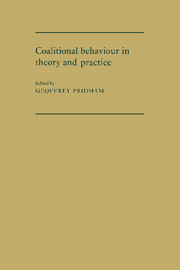Book contents
- Frontmatter
- Contents
- List of illustrations
- List of tables
- Notes on the contributors
- Preface
- 1 An inductive theoretical framework for coalitional behaviour: political parties in multi-dimensional perspective in Western Europe
- 2 Between theoretical elegance and political reality: deductive models and cabinet coalitions in Europe
- 3 Changing coalitional preferences among West German parties
- 4 The FDP and coalitional behaviour in the Federal Republic of Germany: multi-dimensional perspectives on the role of a pivotal party
- 5 Cabinet stability in the French Fourth Republic: the Ramadier coalition government of 1947
- 6 Coalition formation and maintenance in Belgium: a case-study of elite behaviour and changing cleavage structure, 1965–1981
- 7 The Dutch Christian Democratic party and coalitional behaviour in the Netherlands: a pivotal party in the face of depillarisation
- 8 Coalition or Fianna Fail? The politics of inter-party government in Ireland
- 9 Italy's party democracy and coalitional behaviour: a case-study in multi-dimensionality
- 10 Party coalitions in the first democratic period in Spain, 1977–1982
- 11 Coalitional theory and practice in Scandinavia
- 12 Multi-dimensional approaches to the study of local coalitions: some cross-national comparisons
- 13 Research notes
- Index
4 - The FDP and coalitional behaviour in the Federal Republic of Germany: multi-dimensional perspectives on the role of a pivotal party
Published online by Cambridge University Press: 05 November 2011
- Frontmatter
- Contents
- List of illustrations
- List of tables
- Notes on the contributors
- Preface
- 1 An inductive theoretical framework for coalitional behaviour: political parties in multi-dimensional perspective in Western Europe
- 2 Between theoretical elegance and political reality: deductive models and cabinet coalitions in Europe
- 3 Changing coalitional preferences among West German parties
- 4 The FDP and coalitional behaviour in the Federal Republic of Germany: multi-dimensional perspectives on the role of a pivotal party
- 5 Cabinet stability in the French Fourth Republic: the Ramadier coalition government of 1947
- 6 Coalition formation and maintenance in Belgium: a case-study of elite behaviour and changing cleavage structure, 1965–1981
- 7 The Dutch Christian Democratic party and coalitional behaviour in the Netherlands: a pivotal party in the face of depillarisation
- 8 Coalition or Fianna Fail? The politics of inter-party government in Ireland
- 9 Italy's party democracy and coalitional behaviour: a case-study in multi-dimensionality
- 10 Party coalitions in the first democratic period in Spain, 1977–1982
- 11 Coalitional theory and practice in Scandinavia
- 12 Multi-dimensional approaches to the study of local coalitions: some cross-national comparisons
- 13 Research notes
- Index
Summary
Introduction
Given that every elected national government in the 35-year history of the Federal Republic of Germany has been a coalition of varying political complexions and that the creation of an economically successful and stable social structure is often assumed to have resulted from the constant necessity for compromise by the participating parties, it might be expected that numerous studies of coalitional behaviour in the post-war Republic would now exist.
Whilst many aspects of the country's development have been studied in detail and several excellent and wide-ranging books written as a result (Baker et al. 1981; Conradt 1982; Doring and Smith 1982), both the formation and the maintenance of federal coalitions have been neglected as topics worthy of analysis by social scientists. Mass electoral behaviour, the establishment of a new ‘political culture’ and the policy outputs of the party system have all received greater attention, as have the roles and functions of the major political parties since 1949, the SPD (Social Democrats) and the CDU/CSU (Christian Democrats).
The third party in the system for most of the post-war period, the FDP (Free Democrats), has only rarely been investigated in any depth, although some aspects of its behaviour were highlighted in the different chapters of the book edited by Albertin (1980). Recent work on coalitions in the Federal Republic (Norpoth 1982; Schmidt 1983; von Beyme 1983) has looked more closely at the role of the FDP, but these analyses did not consider the party in terms of a coherent framework which emphasises the impact of ‘party factors’ in coalitional behaviour.
- Type
- Chapter
- Information
- Coalitional Behaviour in Theory and PracticeAn Inductive Model for Western Europe, pp. 72 - 92Publisher: Cambridge University PressPrint publication year: 1986

